|
October 2010 - December 2010 |
| |
|
|
 |
|
 |
| |
Publisher:
Chairman Ching-Fuh Lin Editors:
Professor I-Chun Cheng, Ms. Hsiao-wen Lin January 30,
2011 |
| |
|
 |
|
Congratulations! GIPO Distinguished Research Chair Professor Teresa H. Meng receives NTU’s “Outstanding Alumnus” award.
Congratulations! GIPO Professor Chi-Kuang Sun is awarded Taiwan Photonics Society’s “2010 Photonics Engineering Award”.
Congratulations! GIPO Professor Chung-Chih Wu executes the Interdisciplinary Training Program for Technology Talents in Organic Optoelectronics and Display and receives the Merit Award of “2009 Interdisciplinary Training Program for Talented College Students in Science” from Ministry of Education.
|
|
 |
|
 |
|
| |
|
 |
|
October “Photonics Forum” Lecture
Highlights
(Compiled by Li-Chi Yao) |
|
|
October 8th, 2010 (Friday), 12:20 pm |
|
Speaker: |
Dr. Rick Tsai
(General Manager of the New Businesses Department, Taiwan Semiconductor Manufacturing Co., Ltd., TSMC) |
|
Topic: |
Limitless Opportunities in Moving Toward Green Energy |
| |
Dr. Rick Tsai visited GIPO on October 8th (Friday), and delivered his lecture, “Limitless Opportunities in Moving Toward Green Energy” at Auditorium 101, Barry Lam Hall. He introduced the current development of photonics and optoelectronics and their future prospects. The event attracted many GIPO professors and students, and everyone learned much from his lecture.
|
| |
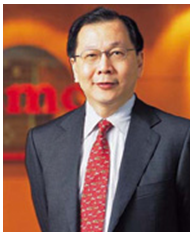 |
|
Speaker Dr. Rick Tsai |
|
|
|
October 15th, 2010 (Friday), 3:30 pm |
|
Speaker: |
Mr. Ching-Wen Cheng
(famous writer and alumnus of Department of Business Administration, NTU) |
|
Topic: |
Writing Experiences |
| |
Mr. Ching-Wen Cheng visited GIPO on October 15th (Friday), and delivered his speech, “Writing Experiences” at Auditorium 101, Barry Lam Hall. Mr. Cheng was a winner of the Kiriyama Pacific Rim Book Prize for fiction, a winner of the 9th National Culture and Arts Award, and was also honored by World Chinese Literature Lifetime Achievement Award. He is adept at depicting turbulent, emotional stories with delicate touches and at revealing vicissitude in eras and in society through the inner lives of average people. GIPO professors and students attended the event with enthusiasm and learned much from the speech. |
| |
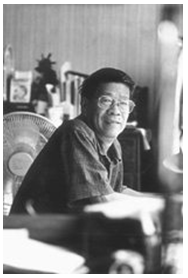 |
|
Speaker Mr. Ching-Wen Cheng |
|
|
|
October 22nd, 2010 (Friday), 3:30 pm |
|
Speaker: |
Mr. Sheng-Yen Lien (Honorary Chairman of Dann-Ru Calligraphy Society) |
|
Topic: |
Calligraphy and Life |
| |
Mr. Sheng-Yen Lien visited GIPO on October 22nd (Friday), and gave a presentation on the topic of "Calligraphy and Life" at Auditorium 101, Barry Lam hall. Mr. Sheng-Yen Lien is the direct disciple of Dann-Ru Chio-Pu Tsao, renowned modern Taiwanese calligrapher. Sheng-Yen has studied 8 styles of calligraphy thoroughly, and has mastered each. He has devoted himself to the art for more than 40 years. He studies works from the past and takes traditional calligraphy as the foundationto create his own style. He was the principal of Ching-Chwan Commercial High School in Taipei County, a representative of the National Assembly, the chairman of Dann-Ru Calligraphy Society, the chairman of China Calligraphy Society, a member of the appraiser panel of Provincial Fine Arts Exhibition, and a member of the appraiser panel of the National Fine Arts Exhibition. He has dedicated himself to educational activities related to calligraphy, and has been awarded
the "Culture and Arts Celebrity Prize" of Taipei County,
the "Global Chinese Culture & Calligraphy Art Award" of Republic of China Senior Jaycees Club, and
the "Literature and Arts Award, Calligraphy" of the Chinese Literature and Arts Association. He was also invited to hold a retrospective exhibition of his past 70 years' works in April, 2008, at the Chung Shan National Gallery of National Dr. Sun Yat-sen Memorial Hall, which was widely-praised and held in high regard by the calligraphers in the country and worldwide. |
| |
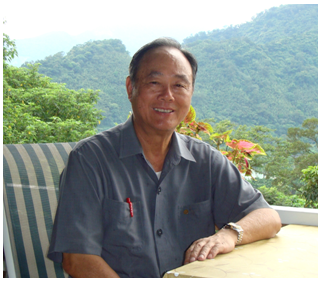 |
|
Speaker Mr. Sheng-Yen Lien |
|
|
|
October 29th, 2010 (Friday), 3:30 pm |
|
Speaker: |
Professor Xing-Yi Wu (Professor of Biomedical Engineering, Department of Industrial Engineering, Texas A&M University) |
|
Topic: |
Photo-acoustic Imaging |
| |
Professor Xing-Yi Wu visited GIPO on October 29th (Friday). He delivered a lecture on the topic of “Photo-acoustic Imaging” in Auditorium 105, EE Building II. GIPO professors and students attended with enthusiasm. Professor Wu’s lecture was fascinating and informative, and he interacted with the audience throughout the event. |
| |
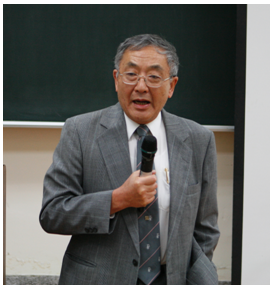 |
|
Speaker Professor Xing-Yi Wu |
|
|
November “Photonics Forum” Lecture
Highlights
(Compiled by Li-Chi Yao) |
|
|
November 4th, 2010 (Thursday), 10 am |
|
Speaker: |
Professor Pei-Cheng Gu
(Department of Electrical Engineering and Computer Science, University of Michigan) |
|
Topic: |
Scaling of Semiconductor Lasers and Solar Cells Using Plasmonics |
| |
Professor Pei-Cheng Gu visited GIPO on November 4th (Thursday), and lectured in Auditorium 105, EE Building II. His lecture explored the topic of “Scaling of Semiconductor Lasers and Solar Cells Using Plasmonics”. |
|
|
November 12th, 2010 (Friday), 3:30 pm |
|
Speaker: |
Professor Kunji Chen
(State Laboratory of Solid State Microstructures and Department of Physics, Nanjing University) |
|
Topic: |
Silicon Based Photonic Quantum Dots and Photonic Molecules |
| |
Professor Kunji Chen visited GIPO on November 12th (Friday) and lectured in Auditorium 101 of Barry Lam Hall. His lecture was titled “Silicon Based Photonics Quantum Dots and Photonics Molecules”. Professor Chen’s main areas of study include nano-semiconductor materials, nano-quantum electronics and nano-photonics. GIPO professors and students attended the lecture with enthusiasm. The content of Professor Chen’s lecture was exciting and he interacted with his audience throughout the event. |
| |
 |
| Speaker Professor Kunji Chen |
|
|
|
November 30th, 2010 (Tuesday), 10:30 am |
|
Speaker: |
Professor Ajoy Kar
(Physics Department, Heriot Watt University) |
|
Topic: |
Laser Written Active and Passive Waveguide Devices |
| |
Professor Ajoy Kar arrived at GIPO on November 30th (Tuesday) and lectured in Auditorium 105, EE Building II on the topic of “Laser Written Active and Passive Waveguide Devices”. GIPO professors and students attended the lecture with enthusiasm and everyone benefited greatly from the experience. |
| |
 |
| Speaker Professor Ajoy Kar |
|
|
|
December 1st, 2010 (Wednesday), 10:30 am |
|
Speaker: |
Professor Min Qiu
(KTH Royal Institute of Technology) |
|
Topic: |
Plasmonic Metamaterial Absorber at Optical Regime |
| |
Professor Min Qui visited GIPO on December 1st (Wednesday) and lectured in Auditorium 105 of EE Building II. The lecture was titled “Plasmonic Metamaterial Absorber at Optical Regime”. Professor Min Qiu’s speech was exciting and he interacted with his audience throughout the event. Everyone benefited greatly from it. |
| |
 |
| Speaker Professor Min Qiu |
|
|
|
December 2nd, 2010 (Thursday), 11 am |
|
Speaker: |
Professor Chinlon Lin
(Bell Labs and Bellcore (USA, retired); Formerly Professor of Photonics and Director, Center for Advanced Research in Photonics, Chinese University of Hong Kong) |
|
Topic: |
Fiber-optic Communication and Global Broadband Network --- dedicated to Professor Kuen Gao, 2009 Nobel Physics Prize Laurel Winner |
| |
2010 marks the 40th anniversary of the invention of low-loss optical fibers, which, designed specifically for high-capacity and long-distance communications, has thoroughly changed the world by virtue of its utterly unlimited communication capacity. Nowadays, the use of widespread laid global fiber-optic networks has meant that broadband information infrastructures have been developed in most countries and have unfolded its tremendous, far-reaching and high-speed telecommunication capabilities to the world. For his incredible contribution in expediting the invention of low-loss fiber-optic, Professor Dr. Charles K. Kao, former president of the Chinese University of Hong Kong and a pioneer of fiber-optic communication development shared the 2009 Nobel Physics Prize laurel with Dr. W. Boyle and Dr. G. Smith of Bell Labs, who have invented CCD devices for digital electronic imaging. This seminar covers early stories of photonics and fiber-optic communication developments, and explores the important influence of fiber-optic and global broadband networks on information communication in modern human society. We, herewith, humbly present this seminar to applaud Professor Kuen Gao for his honorable achievement in receiving the Nobel Physics Prize. |
| |
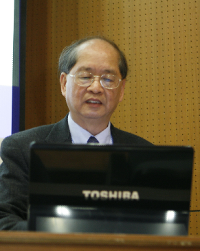 |
 |
| Speaker Professor Chinlon Lin |
2009 Nobel Physics Prize Laurel Winner
Professor Kuen Gao visits College of EECS |
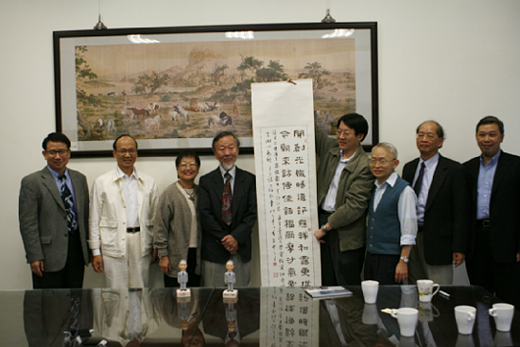 |
|
Professor Kuen Gao and Mrs. Gao (third left and fourth left) in the dean’s office, accepting souvenirs from Dean Lin-Shan Lee, EECS (third right). |
|
|
GIPO Distinguished Research Chair Professor Teresa H. Meng visits (November 16th, 2010)
|
GIPO Distinguished Research Chair Professor Teresa H. Meng returned to EECS, NTU on November 16th. Dr. Meng gave a lecture titled “Engineer, Educator and Entrepreneur” and spoke with the faculty and students.
|
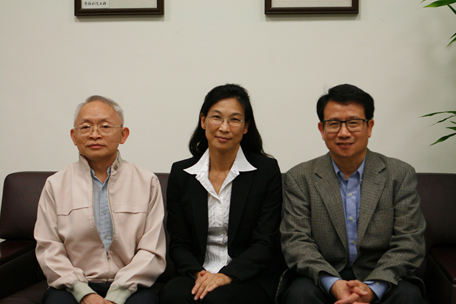 |
|
GIPO Distinguished Research Chair Professor Teresa H. Meng (middle), with Dean Lin-Shan Lee, EECS (left), Chairman Ching-Fuh Lin, GIPO (right) in the dean’s office |
|
|
 |
|
 |
|
| |
|
 |
~ 2010 Ph.D. Student Exchange with Nanjing University ~
(The 3rd Cross-Strait Ph.D. Student Forum on Photonic Science and Technology, 2010)
(Time: October 25th to October 26th, 2010; Location: National Taiwan University)
Composed
by Po-Chun Yeh, GIPO Ph.D. candidate
This was the 3rd exchange between the Ph.D. students from Nanjing University and from National Taiwan University. GIPO of NTU sponsored this year's event. Professor Shining Zhu, Dean of the College of Physics, NJU, and Professor Zhenlin Wang, Associate Dean, headed the NJU team. They were accompanied by Professor Xiangfei Chen, and Gang Zhao and Liang Sun, two teachers. In recent years, academic exchanges between both sides have been gaining regard and become importance. This year, members of the visiting team have increased to 15 Ph.D. students; they are from Nanjing University, Nanjing Normal University, Nanjing University of Science and Technology and Soochow University respectively.
The exchange began on October 24th and ended on October 30th, 2010. The formal conference was held on October 25th and 26th at 201 conference room, Barry Lam Hall, NTU. 5 teachers and 15 students from the NJU team, Professor Chi-Kuang Sun, Associate Dean of the College of EECS, Professor Ching-Fuh Lin, Chairman of GIPO, Professor Chih-I Wu, Vice Chairman of GIPO, and 10 GIPO doctoral students from NTU attended the opening ceremony. Aside from those mentioned above, there were also several other GIPO professors in attendance. Immediately after the opening ceremony, Dean Shining Zhu and Chairman Ching-Fuh Lin introduced the NJU and NTU teams. In his introduction, Dean Shining Zhu notes that Chien-Shiung Wu and Kwoh-Ting Li were both NJU alumni, which brought us to realize the close relationships between NJU and Taiwan's academic, technology and economic development.
Both the number of schools and participants have increased this year, which made the conference more action-packed than ever before. There were 8 subjects on the agenda, including: nonlinear photonic devices, solid state lighting and display, physics optics & microscopy, integrated optics devices I - waveguide, integrated optics devices II - grating, laser optics & optical devices, nano photonics, and optoelectronic materials. Each student representative had 25 minutes to introduce his laboratory and present his research work to the audience. As the presentation were all given in Chinese, both teams were able to interact more directly and more deeply. Many of the presentations caused fervent discussion among participants, and the discussion continued even during breaks. It could easily be seen that both teams were very interested in each other's research works.
The next morning, we invited professors from both teams to give lectures. Associate Dean Zhenlin Wang of College of Physics, NJU, introduced his team's research which involved creating photonic crystal from microspheres. His abundant and profound presentation, along with his smooth and assured manner of speaking revealed his scholarly style. Vice Chairman Chih-I Wu of GIPO, NTU, represented our team, and gave a lecture on the research of organic light-emitting diodes. His research covers both theory and application. These two professors' lectures set good examples for the students and evoked enthusiasm in students for pursuing research.
 |
| Participants outside Barry Lam Hall |
We arranged three-day-long visiting activities for the NJU team beginning on October 27th and ending on October 29th. They visited GIPO's laboratories, Taiwan Semiconductor Manufacturing Company Limited (located in Hsinchu Science Park), and AVerMedia Information Inc. (located in Zhonghe District). We also took advantage of this opportunity to visit National Palace Museum, Chiang Kai-Shek Memorial Hall, and Taipei 101 as well. In addition to academic interaction, we also interacted with the mainland teachers and students in culture, life and industry. Both teams learned a lot from each others’ cultures.
During the week, through exciting academic interaction, we have felt the mainland students' dedication to the research. Every student representative has shown his outstanding research accomplishments. We are glad to have interacted with and to have learnt from such outstanding friends. This experience has made us more dedicated to our own work as well. Throughout the week-long interaction, we observed the differences in wording, customs and experiences; however, the friendship and enthusiasm led us to realize that it is not far between the two sides of the strait.
 |
| Visiting TSMC |
Composed
by Yung-Hsiang Lin, GIPO Ph.D. candidate
The 3rd Cross-Strait Ph.D. Student Forum on Photonic Science and Technology, 2010, presided by Ching-Fuh Lin, Chairman of GIPO, NTU, and Shining Zhu, Dean of the College of Physics, NJU, came to a successful close. During the two-day-long forum, held at 201 conference room, Barry Lam Hall, NTU, Professor Chih-I Wu, Vice Chairman of GIPO, NTU, Professor Zhenlin Wang, Associate Dean, College of Physics, NJU, and 25 Ph.D. students from National Taiwan University, Nanjing University, Nanjing Normal University, Nanjing University of Science and Technology and Soochow University, presented the fruits of their research, and learnt from each other. During the presentations, participants listened attentively, raised questions and discussed related subjects enthusiastically afterward. Everyone in attendance said he or she gained a lot from the forum. Among them, Po-Sheng Wang and Wen-Lan Yeh of NTU and Xiang Xiong and Xin-Jie Lv of NJU have each been awarded the "best thesis prize" for their excellent theses and splendid presentations. Both teams exchanged souvenirs after the forum.
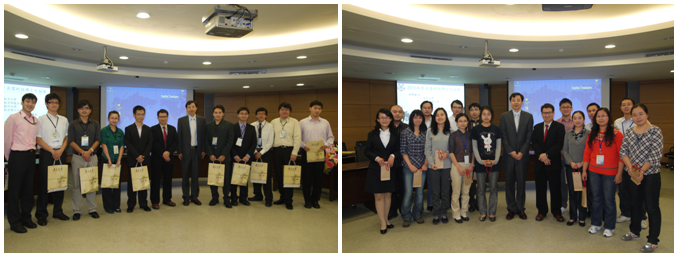 |
| NTU and NJU students exchange gifts after the closing ceremony |
Aside from academic interactions during the forum, students from both teams made use of the breaks to get to know each other better and exchanged viewpoints concerning international affairs, educational developments, career plans and cross-strait cultures. The event not only helped students grow in their scientific research, but also broadened their horizons and cultivated their global vision.
Doing our best to be the host, GIPO arranged a three-day-tour after the end of the two-day-forum, and entertained our guests with traditional Taiwanese gourmet food. They were very impressed by our hospitality and praised Taiwan as a beautiful island filled with treasures.
 |
| A tour of the NTU campus |
We arranged a sightseeing tour of NTU campus and visits to GIPO’s related laboratories for our guests. First, we stopped by NTU Heritage Hall of Physics, including the Nuclear Physics Laboratory and the General Physics Homemade Experiments Exhibition Gallery, which enabled our guests to better understand early scientific developments in Taiwan. Afterward we visited GIPO's laboratories, including Photonics Processing Laboratory and several GIPO professors' laboratories. We appreciated the kind assistance of Professor Gong-Ru Lin's laboratory and Professor Chih-I Wu's laboratory in this event.
In addition, we arranged our guests to pay a visit to the National Palace Museum, Chiang Kai-Shek Memorial Hall and Taipei 101. During the tour in National Palace Museum, they were very happy to have the opportunity to appreciate the museum's collections of wonderful Chinese treasures, and praised the beauty of Chinese culture while visiting. At Chiang Kai-Shek Memorial Hall, our guests were greatly impressed by the towering style and grandiose nature of the architecture of the main hall and the National Theater and Concert Halls. The Taipei 101 tower is Taipei's landmark, and our guests certainly did not want to miss it. They have admired the modern beauty of Taipei's luminous night sky and lingered on without any thought of leaving while in the tower's observatory.
This interaction has enriched friendships among professors and students of National Taiwan University, Nanjing University, Nanjing Normal University, Nanjing University of Science and Technology and Soochow University. We are all looking forward to meet each other again in Nanjing next year.
|
|
|
 |
|
 |
|
| |
|
 |
|
Surface
Tension and Concentration Measurement of
Sub-mL Solution Using a Cantilever-Based
Optical Gauging System
Professor Jui-che Tsai
Graduate Institute of Photonics and
Optoelectronics, National Taiwan
University
A
cantilever sensor integrated with an
on-tip micro spherical reflecting mirror
(MSRM) exhibits a larger optical beam
displacement than a conventional one,
i.e., the system sensitivity/responsivity
is enhanced. In our study, it is
employed as a surface tension and
concentration gauge that only requires
0.5
mL of solution.
The
MSRM-integrated cantilever is first set
above a sodium chloride-water droplet
carried by a glass substrate, and then
the droplet is moved up gradually. Once
the cantilever is touched by the
droplet, it is pulled and bent down as
the droplet reshapes. The cantilever
deformation amount is related to the
surface tension of the solution, which
increases with the molar concentration
of sodium chloride. According to our
experiments, the surface tension varies
from 72.1 to 77.7 mN/m as the molar
concentration of sodium chloride in
water increases from 0 to 3.13 M (Fig.
1). Therefore, by measuring the bending
amount of the cantilever, the surface
tension as well as the concentration of
the NaCl-water solution can be
determined. We also perform the
experiments on the alcohol
(ethanol)-water mixture, whose surface
tension, conversely, reduces from 71.4
to 57.5 mN/m as the alcohol molar
concentration increases from 0 to 0.81 M
(Fig. 2).
|
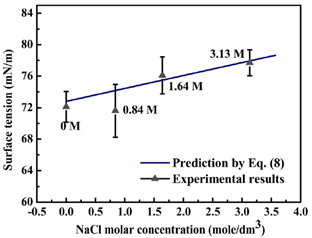 |
|
Fig. 1 |
|
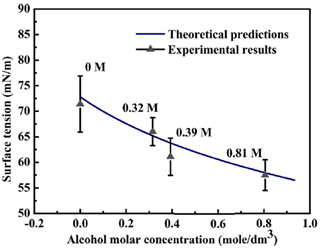 |
|
Fig. 2 |
© 2010
IEEE
C. D.
Liao, K. H. Chao, and J. C. Tsai,
"Surface tension and concentration
measurement of sub-mL solution using a
cantilever-based optical gauging
system," IEEE Journal of Quantum
Electronics, Vol. 46, No. 9, pp.
1268-1274, September 2010.
Arbitrary-Order Interface Conditions for
Slab Structures and Their Applications
in Waveguide Analysis
Professor Yih-Peng Chiou
Graduate Institute of
Photonics and Optoelectronics, National
Taiwan University
Convergence of truncation
error is one of critical factors in
finite-difference simulation. Since
step-index structure is a common feature
in recent photonic devices design,
traditional formulation based on
graded-index (GI) and index averaging
(IA) scheme cannot accurately model
field behavior near abrupt interfaces
between different materials. We derive
generalized interface conditions of
arbitrary orders combined with Taylor
series expansion in homogeneous region
for TE and TM mode calculation of
step-index waveguide. We also adopt
generalized Douglas (GD) scheme for
further convergence order without
demanding more reference points.
We model a
multiple-quantum-well (MQW) waveguides
with 56 barriers and 55 wells as an
assessment. Refractive indices of
cladding, barrier, and well are 3.2224,
3.2874, and 3.3704, respectively. Widths
of each barrier and well are 12nm and
7nm, respectively. The relative
propagation constant error of
fundamental TE and TM modes illustrated
in Fig. 2
shows that our proposed scheme using (2N+1)-point
without GD yields convergence between
O(h2N-1) and O(h2N),
or O(h2N+1) and O(h2N+2)
if GD is adopted. The high-order
convergence can greatly reduce
computation effort of waveguide
analysis. Formulation can also be
applied to other simulation methods such
as beam propagation method.
|
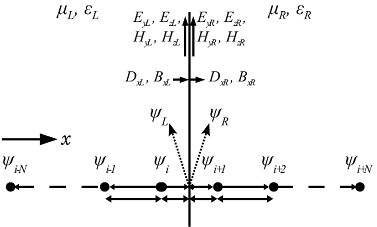 |
|
Fig. 1 Illustration of
field continuity and sample points. |
|
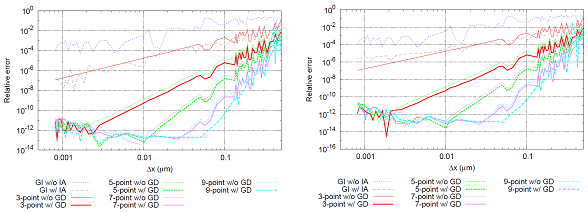 |
|
(a)
(b)
Fig. 2 Relative propagation constant
error of fundamental (a) TE and (b) TM
modes. |
Reference: Y.-P. Chiou and C.-H. Du,
OSA Optics Express, Vol. 18, No. 5,
pp. 4088-4102, Mar. 2010.
|
|
Virtual
Optics: Reconstruction of Light by Means
of Optical Phase Conjugation
Professor Snow H. Tseng
Graduate Institute of Photonics and
Optoelectronics, National Taiwan
University
We
simulate the optical phase conjugation (OPC)
phenomenon of light multiply scattered
through a macroscopic scattering
medium. The pseudospectral time-domain
(PSTD) technique is employed to enable a
virtual optics experiment for analysis.
Specifically, we analyze the OPC
reconstruction phenomenon from various
categories of scattered light and
determine the contribution. We found
that an unbiased ensemble of scattered
light is required to reconstruct the
original incident light.
|
 |
|
Fig. 1. Depicting the Poynting vector
field of light multiply scattering
through a scattering medium. As light
scatters through the scattering medium,
the Poynting vector field in each region
bears different characteristics: (a)
randomly oriented, (b) in general
pointing away from the scattering medium
and anti-parallel to the incident light,
(c) uniformly pointing away from the
scattering medium, and (d) also pointing
away from the scattering medium, but not
as uniform as in (c). |
|
 |
|
Fig. 2. OPC refocused
light from selected local regions shown
in Fig. 1(a-d). A cross-correlation of
each OPC reconstructed light and the
original incident light profile is
calculated. (a) diffuse light within
the scattering medium, correlation
coefficient cc = 2.6´10-4,
(b) enhanced backscattered light, cc=
4.2´10-5,
(c) specularly reflected light, cc
= 4.3´10-6,
(d) diffuse light outside the scattering
medium, cc=3.2´10-5.
As shown in 2(c), the reconstruction
falls short without an unbiased
collection of scattered light. |
Plasmon Field Enhancement in Silver
Core-Protruded Silicon Shell
Nanocylinder Illuminated with Light at
633 nm
Professor Ding-Wei Huang
Graduate Institute of Photonics and
Optoelectronics, National Taiwan
University
We have shown, to the
best of our knowledge, the first
simulation result of the strong
plasmonic field coupling and enhancement
at the Ag/Si interface of a silver
core/protruded silicon shell
nanocylinder by using the finite element
method. The strong plasmon field with a
slow effective phase velocity
accumulated at Ag/Si interface which
results from the large effective index
of surface plasmon due to the nearly
identical real parts with opposite signs
of the permittivities of silver and
silicon at 633 nm is analyzed. When the
silicon shell has shallow protrusions of
proper periodicity to meet the phase
matching condition between the incident
light and the surface plasmon wave at
the Ag/Si interface, a higher scattered
electric field and a higher sensitivity
to the refractive index change of the
surrounding medium can be achieved. The
highest scattering electric field can be
determined by the optimized average
thickness of the protruded silicon
nanoshell and silver core radius. Our
novel concepts may provide a guideline
for designing silver core/protruded
silicon shell nanocylinder for
biosensing applications.
|
 |
|
Fig. 1 Schematic diagrams of (a)
silver core-silicon shell
nanocylinder, (b) silver
core-protruded silicon nanoshell
nanocylinder, and (c) solid
silver nanocylinder. |
Fig. 2 Scattered electric field
as a function of the surrounding
medium for three cases with the
inner radius 100 nm at 633 nm.
|
|
|
 |
|
Fig. 3 Scattered electric field
distributions for Case 2 at 633 nm with
different incident angles. |
|
|
Two Dimensional Electron Gases in Polycrystalline MgZnO/ZnO
Heterostructures Grown by RF-Sputtering
Process
Professor I-Chun Cheng's group
Graduate Institute of Photonics and
Optoelectronics, National Taiwan
University
We study the formation of
two-dimensional electron gas (2DEG) in
rf-sputtered defective polycrystalline
MgZnO/ZnO heterostructure via the
screening of grain boundary potential by
polarization-induced charges. The sheet
resistance reduces rapidly and then
saturates as the MgZnO thickness
increases. Both the mobility and the
sheet carrier concentration in
saturation increase as the Mg content is
raised and reach maxima of 39.4 cm2V-1s-1
and 1.15x1014cm-2
at x=0.4, confirmed by low temperature
Hall measurement. Monte Carlo method by
including grain boundary scattering
effect as well as 2D
finite-element-method Poisson and
drift-diffusion solver is applied to
analyze the polycrystalline
heterostructure. The experimental and
simulated saturation sheet resistance
show good agreement. Both carrier
concentration and mobility are
temperature independent, indicating the
formation of 2DEG with roughness
scattering at the MgZnO/ZnO interface.
Our result suggests that polycrystalline
MgZnO/ZnO material system can be a
potential candidate for the application
of low-cost large-area high electron
mobility transistor (HEMT) devices.
|
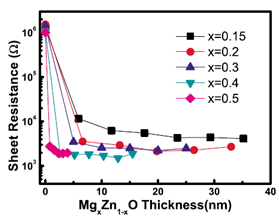 |
|
Figure 1. Sheet resistance of
polycrystalline MgxZn1-xO/ZnO
heterostructure versus thickness of MgxZn1-xO
cap layer for x=0.15, 0.2, 0.3, 0.4, and
0.5. The lines are guides to the eyes. |
|
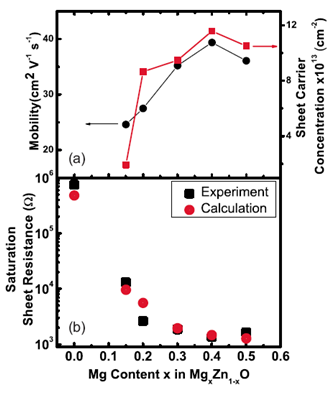 |
|
Figure 2. (a) Hall
mobility and sheet carrier concentration
of MgxZn1-xO/ZnO
heterostructure in saturation as
functions of Mg content x. (b)
Comparison of experimental and
calculated saturation sheet resistances
as functions of Mg content x. The lines
are guides to the eye. |
|
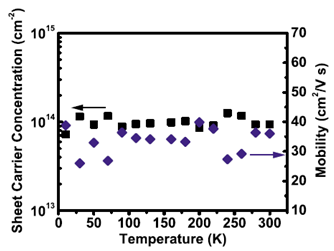 |
|
Figure 3. Hall mobility
and carrier concentration of Mg0.3Zn0.7O/ZnO
heterostructure with Mg0.3Zn0.7O
capping layer thickness of ~30 nm as
functions of temperature. |
Study of Carrier Dynamics and Radiative Efficiency in InGaN/GaN LEDs
with Monte Carlo Method
Professor Yuh-Renn Wu
Graduate Institute of Photonics and
Optoelectronics, National Taiwan
University
In a LED, carriers are
injected from the contacts and diffuse
laterally in the quantum wells (QWs). In
this paper, we apply the Monte Carlo
(MC) method to study the carrier
dynamics in the InGaN QW. The radiative
recombination rate is calculated by a
self-consistent Poisson,
drift-diffusion, and Schrodinger solver.
We set different dislocation densities
and trap cross sections of threading
dislocation, and study the influences to
the device efficiency by MC method. The
effects of alloy scattering, charged
dislocation scattering, interface
roughness scattering, and e-e scattering
are included in our MC model. The
locations of dislocations are arranged
randomly and are depending on
dislocation densities. The electron will
diffuse randomly by scattering in the QW
before recombination. If the electron
incidents into the location of the
threading dislocation, it is captured by
the threading dislocation and recombines
non-radiatively. The diffusion ranges
and the captured chances are influenced
by many scattering mechanisms and will
be discussed in this paper.
Our simulation result shows a strong
dependence on the indium composition
because of the longer radiative lifetime
in the longer wavelength due to QCSE.
The carrier diffusion length with higher
In composition increases because of a
longer radiative lifetime. However, the
diffusion length in a higher In
composition QW will decrease if the
interface roughness scattering is very
strong. The larger diffusion length
leads to a higher capture rate. To
estimate the internal quantum efficiency
(IQE), we need to define the carrier
capturing cross section diameter, δ. The
published TEM results show the threading
dislocation has a carrier trapping
diameter around a few nanometer. Within
these ranges, we start to estimate the
expected IQE. We find that with a larger
interface roughness, the IQE can be
improved by a few percent. If the δ
changes from 2nm to 4nm, the radiative
efficiency will decrease 20% to 30%. If
the dislocation density drops to 106
cm-2, the IQE can be improved
significantly. Since most LEDs are the
lateral LED, there would be a lateral
electric field in QW with a larger
applied bias. Our results show the
efficiency will drop 30% to 70%
depending on the In composition when
applying a small lateral electric field.
The carrier is easier to be captured if
it is drifting with a certain direction
rather than diffusing in a random
direction. This indicates that non-radiative
coefficient, A, is not a constant and
should be strongly dependent on the
bias, δ, and dislocation density. Our
estimated IQE is compared with published
experimental results and shows a good
agreement in the trend. Our results show
that for the longer wavelength source,
we should try to decrease the radiative
lifetime by reducing the QCSE with a
nonpolar/semipolar structure. The other
way is to reduce the dislocation density
to be lower than 106 cm-2.
However, both should be achieved to make
the IQE reaching 100%.
|
 |
|
Fig. 1 (a) Estimated maximum
efficiency versus indium
composition for different
dislocation density values when
n2d is 8x1012
cm-2. Also shown is a
comparison with experimental
results. (b) Estimated e±ciency
versus indium composition with
different dislocation densities
for the nonpolar plane cases. |
|
|
|
|
 |
|
 |
|
| |
|
|
 |
|
 |
|
|
|